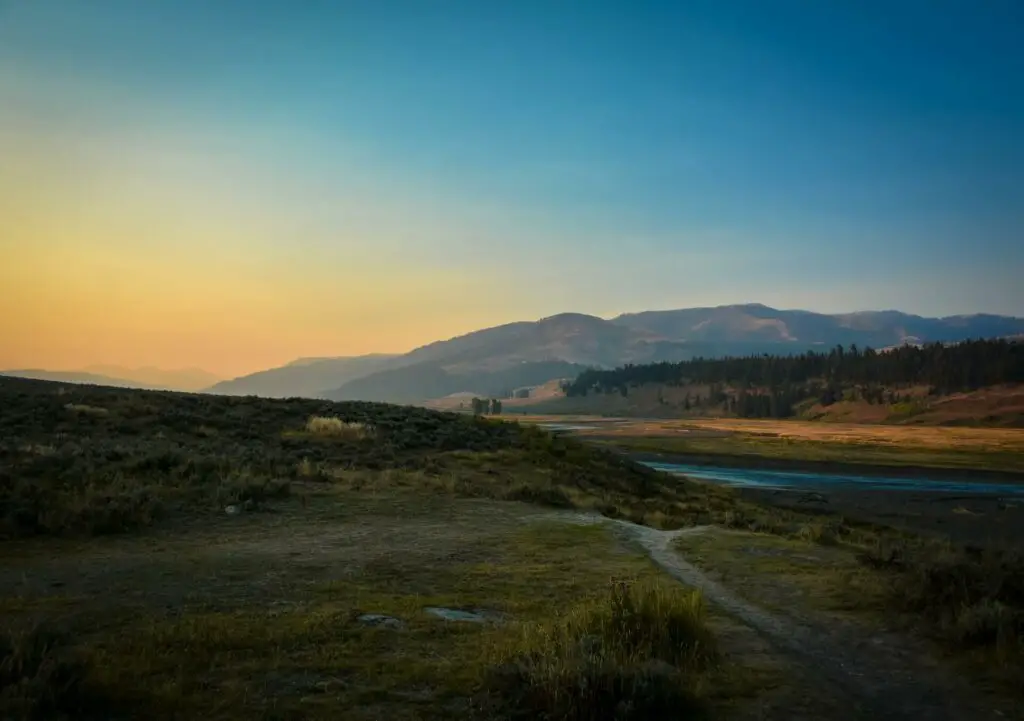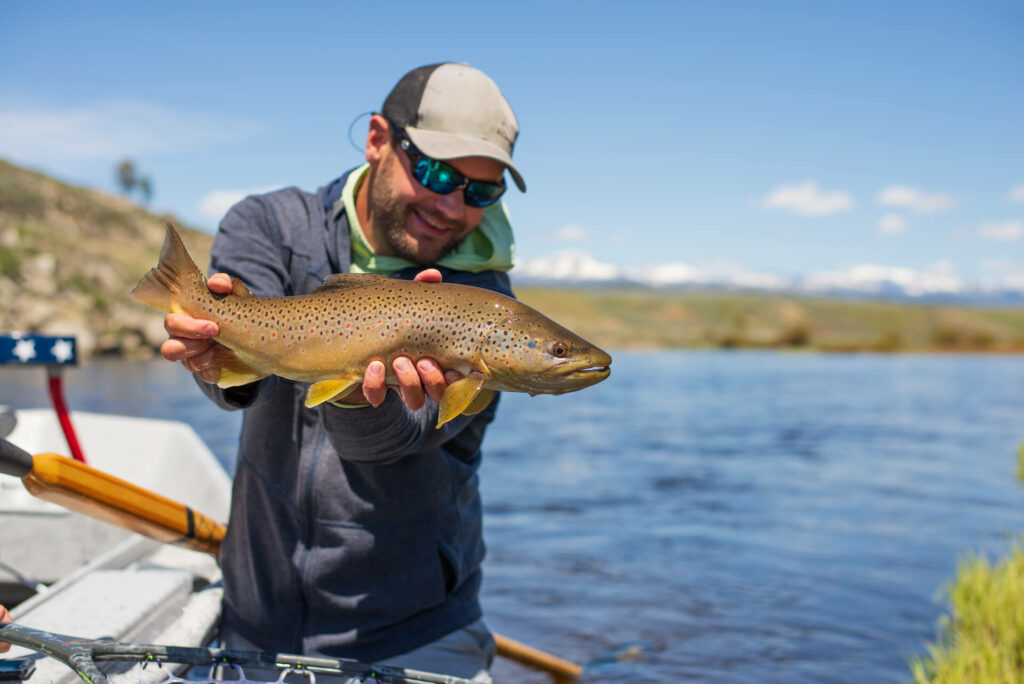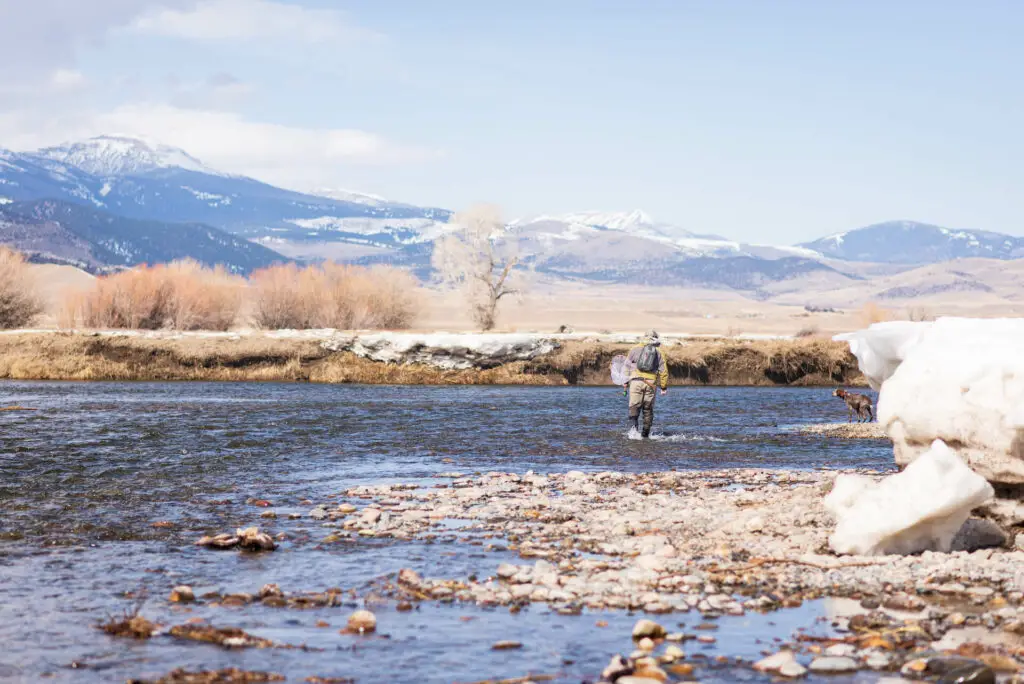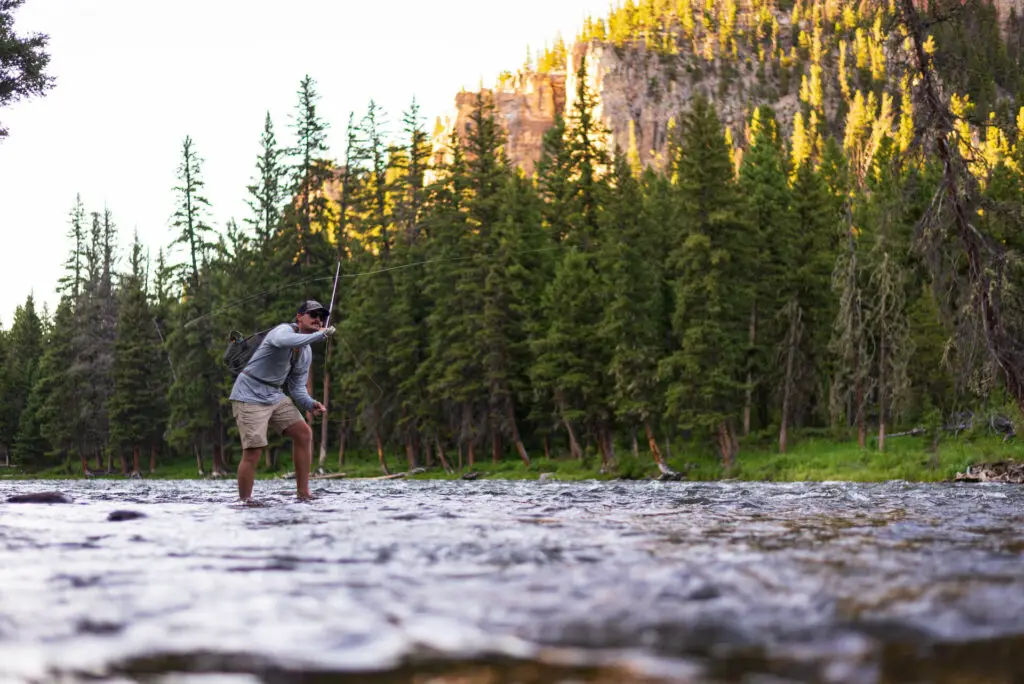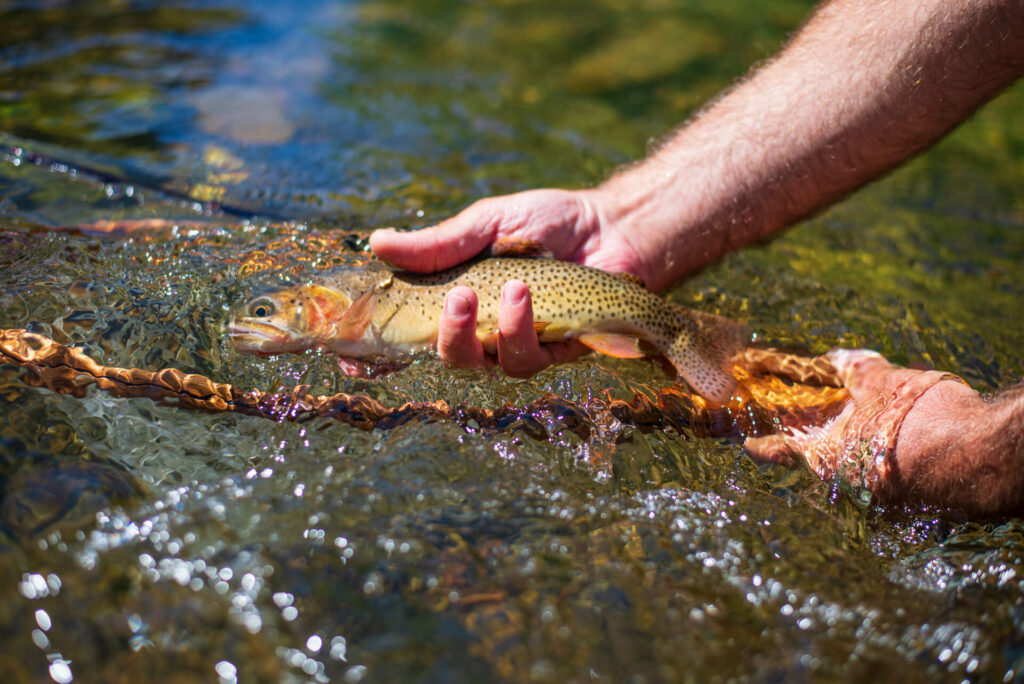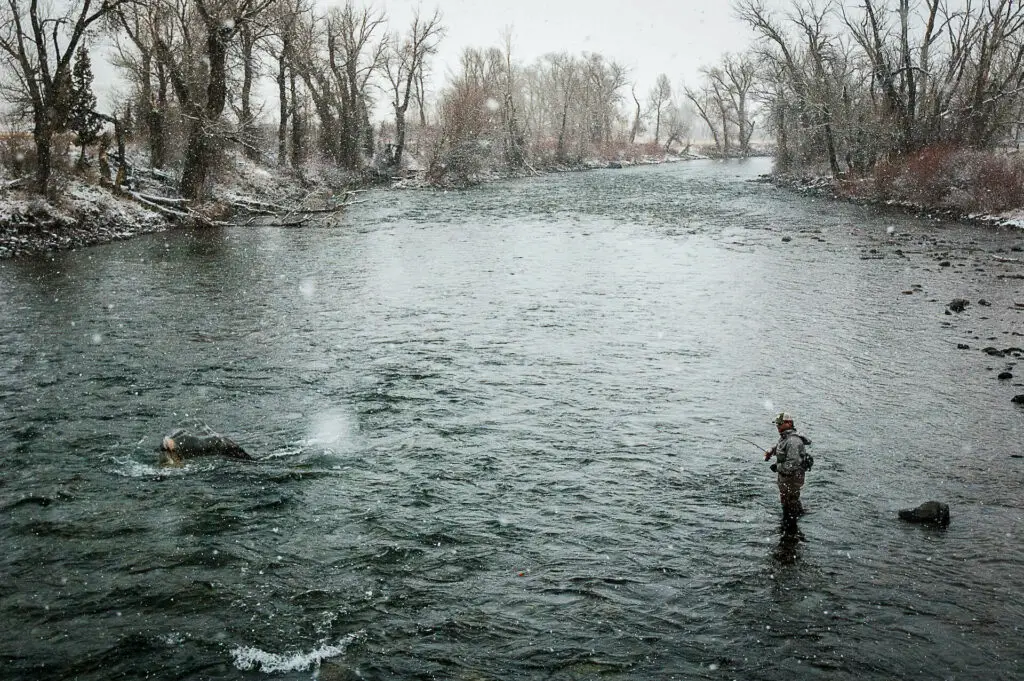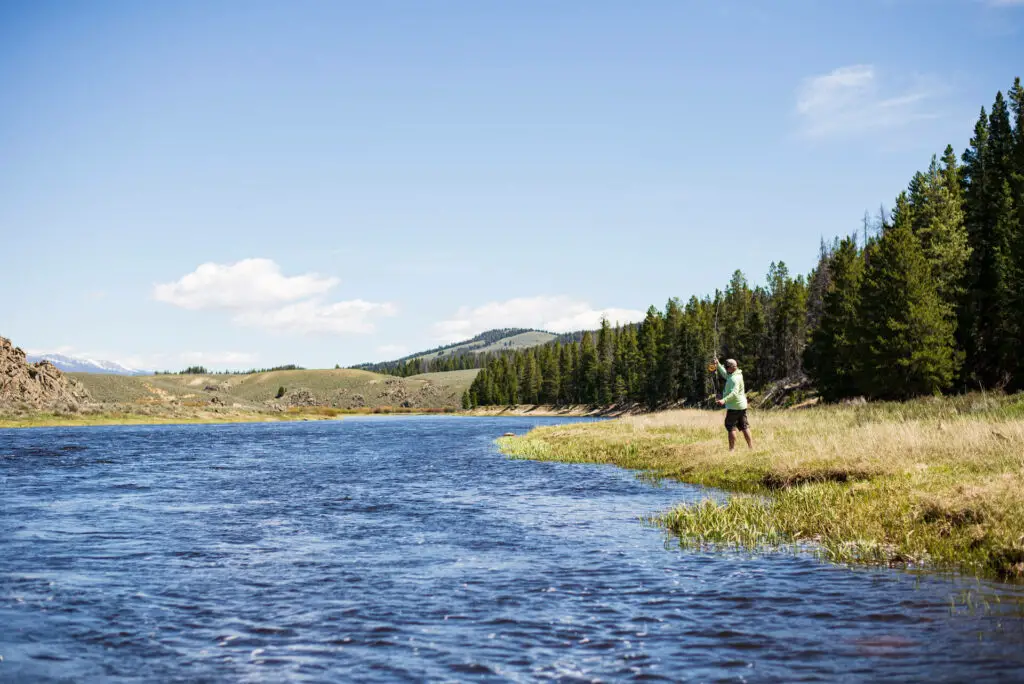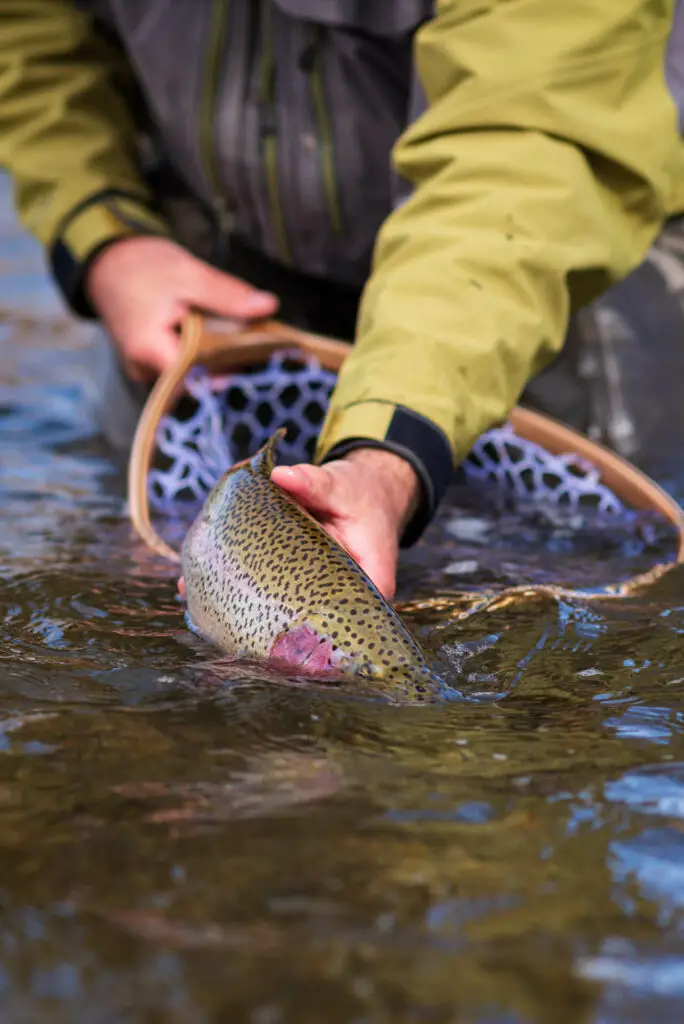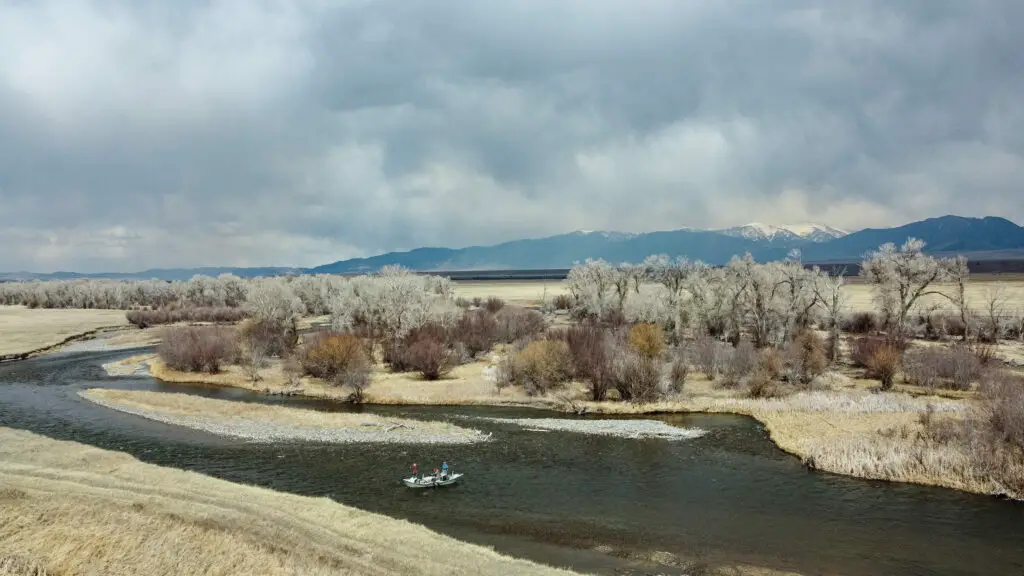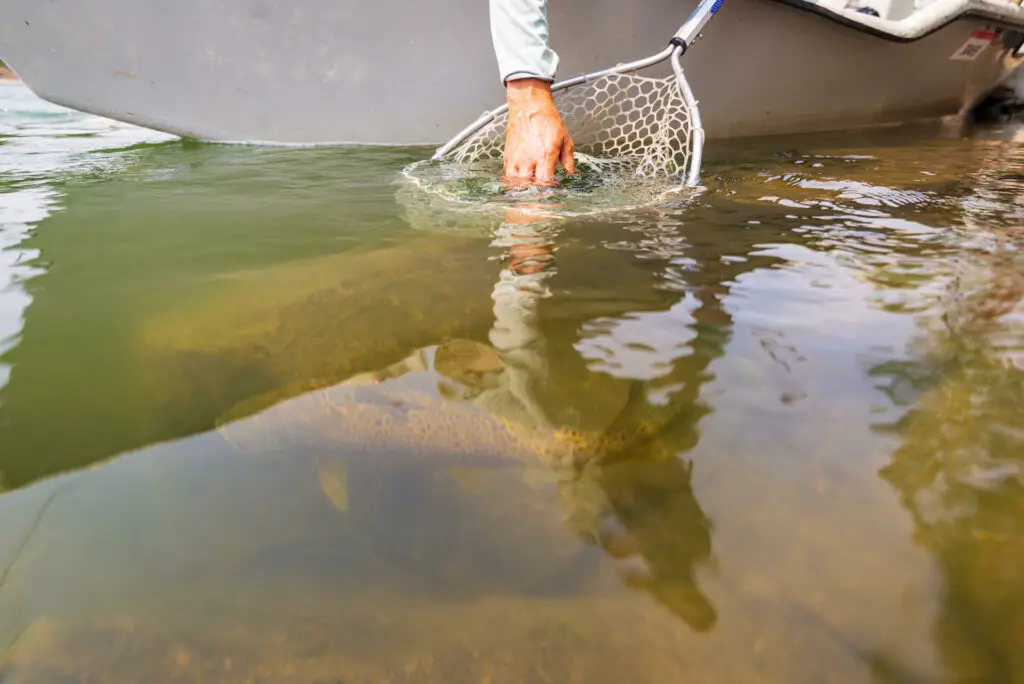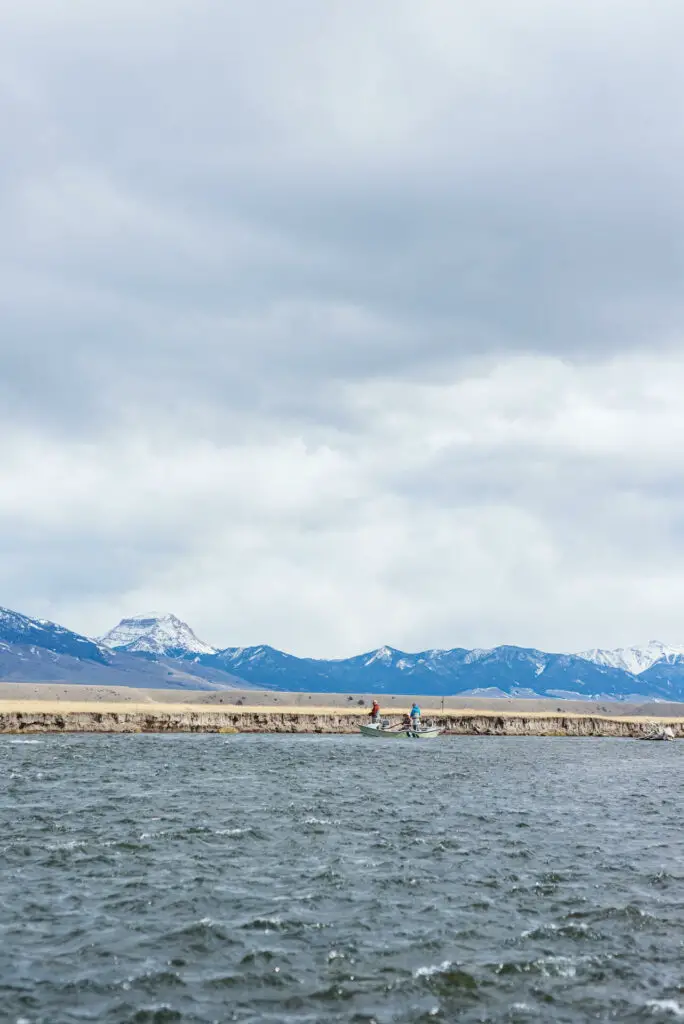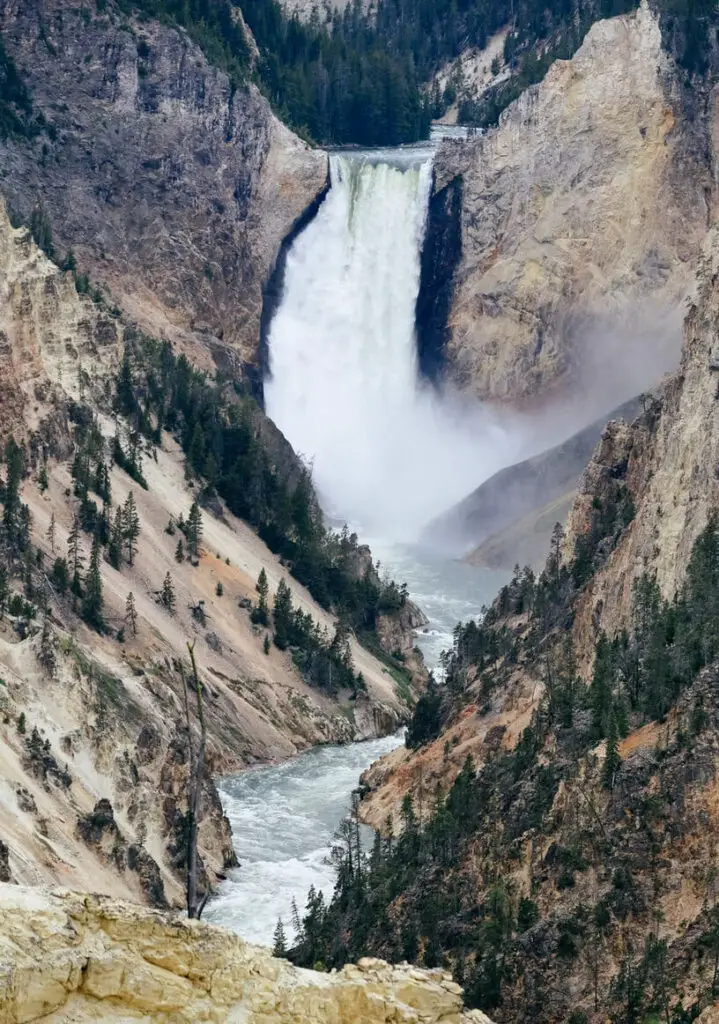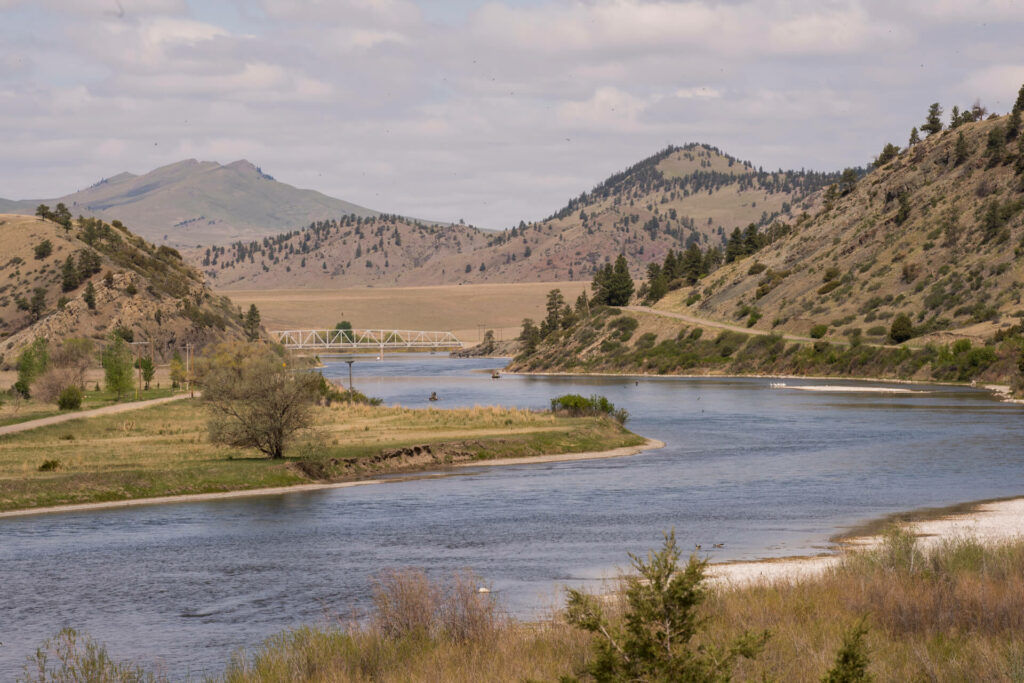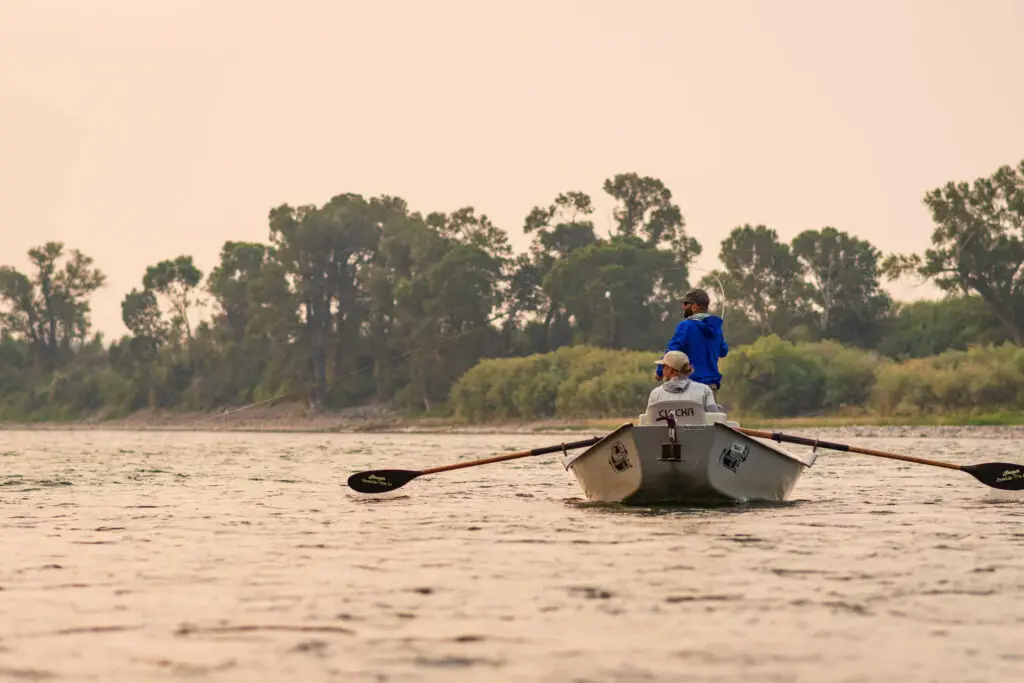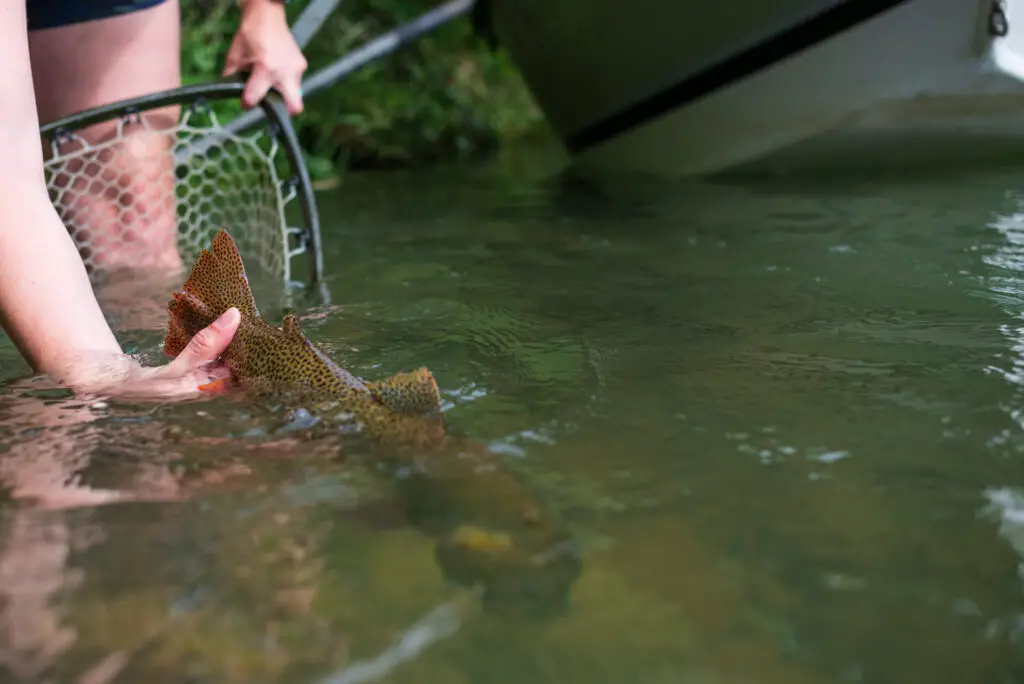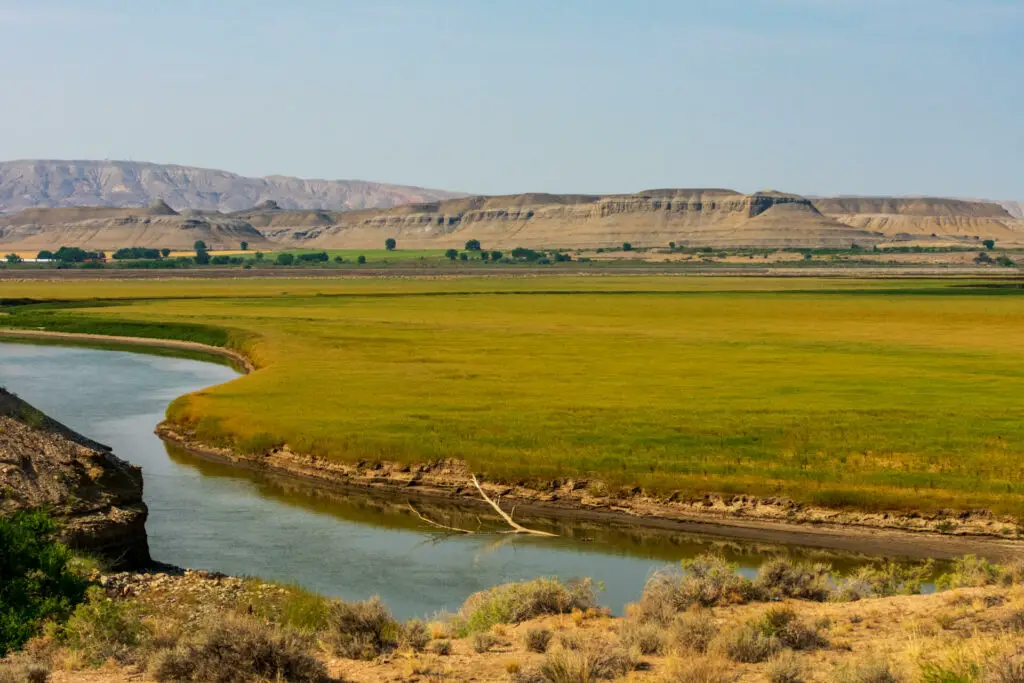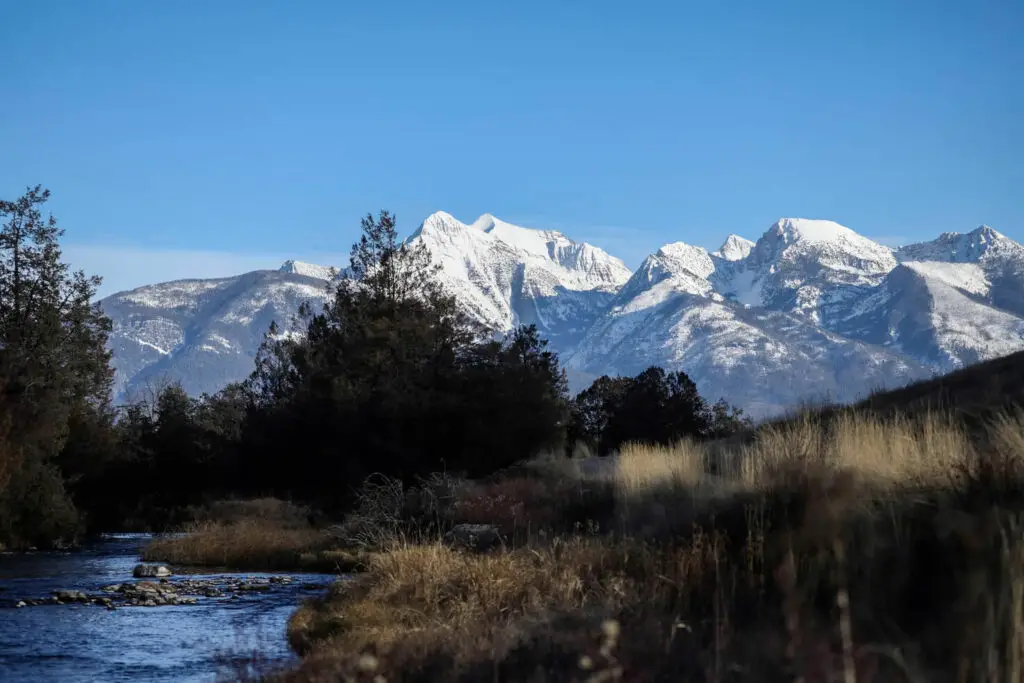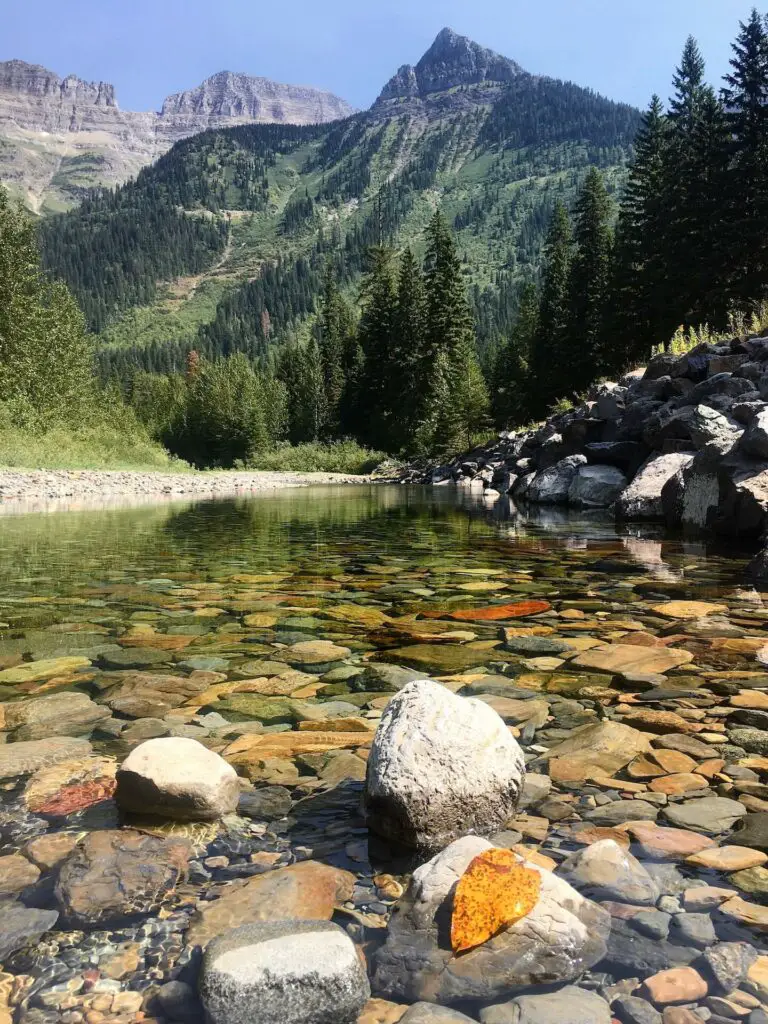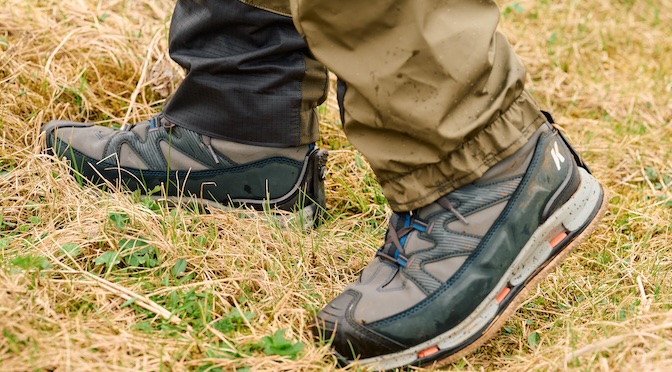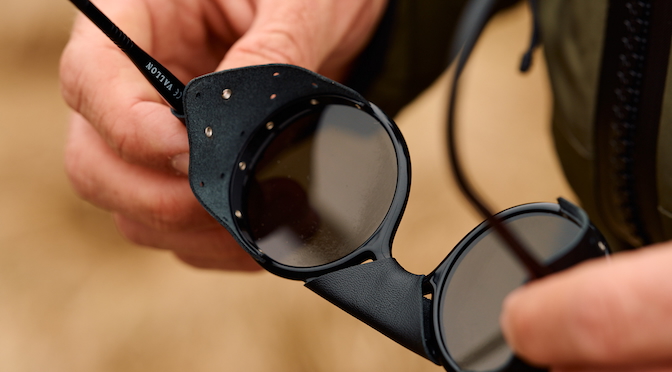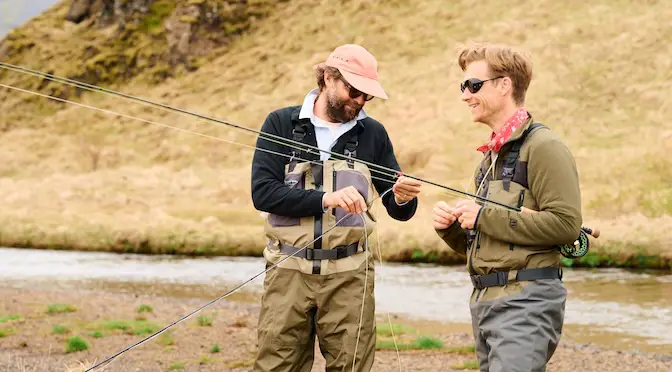Last updated on January 9th, 2024.
- On the Water with the Grundéns Vector Waders - May 7, 2024
- Hands on with the Orvis Encounter Fly Rod Outfit - April 23, 2024
- On the Water with the New Simms G3 Guide Wading Boots - April 15, 2024
Montana is known for its endless skies, friendly people, national parks, and miles of publicly accessible fishing waters.
“Big Sky Country” offers some of the world’s finest fly fishing opportunities for numerous species of trout. Whether you prefer casting tiny dry flies to technical Missouri River rainbow trout, throwing large streamers on the Yellowstone River for trophy browns, or nymphing seams on the endless riffle of the Madison River, there is enough variety to please every angler. Most importantly, Montana’s stream access laws are some of the most liberal in the entire country, but more on that later.
Ranging from high alpine lakes to large freestone, Montana has more fishable water than one could learn in a lifetime. With access and options so vast, it can be overwhelming to determine where you want to spend your time while visiting the state. By the end of this article, my goal is to provide you with enough information to travel to Montana with a perfectly-catered-to-you fishing trip outline. Below, you’re going to learn about the various rivers within Montana, different regions of the state, expected seasonal weather, and more.
Table of Contents:
Recommended flies for Fly Fishing in Montana
Best Fly Fishing Rivers Montana
Conclusion on Fly Fishing Montana
Species to target while Fly Fishing in Montana
Montana is home to an array of fish species, but anglers from around the globe travel here to pursue our famed trout with a fly rod in hand. In addition to whitefish and grayling, Montana boats rainbow, brown, cutthroat, brook, bull, and lake trout. You can catch each of these species on a fly rod. The most daunting problem is making a list of which one to target on your trip to Montana!
Fun fact regarding Montana’s rainbow and brown trout: They were both introduced in 1889 – the same year Montana became a state.
Traveling to Montana
Traveling to and navigating around Montana is pretty easy compared to many congested cities and locations across the U.S. We have five commercial airports, all serviced by major U.S. airlines, all of which will give you access to the majority of Montana’s renown rivers. Those airports are: Billings (BIL), Bozeman (BZN), Great Falls (GTF), Helena (HLN), and Missoula (MSO).
Car rentals from your major providers are also readily available. You can also rent local vehicles. They offer the ability to rent vehicles from private owners rather than a rental company. While I would recommend a rental car of some sort to allow you the flexibility to explore more than one river, Uber and Lyft are also readily available throughout the state.
Weather in Montana
It can and has snowed at any time of the year – however, it is rare to see a snowy day during the summer heat of July and August. Montana begins to warm up in mid-April, right after the skwala stonefly hatches on the western side of the continental divide. For residents, the month of May can be refreshing. Everything begins to blossom, the trees begin to bud and grasses display every shade of green. Weather in May is usually in the 5 to 20 celsius range, but a snow shower can still occur, so always pack a waterproof and insulated jacket.
By June, our average temperatures rise to between 20 and 25 celsius for highs while lows can drop to 5 celsius, so be prepared with that insulated jacket and any other layers you might need. In the first half of the month, expect to see a quick shower or an afternoon thunderstorm most days. A lot of our rivers, particularly the freestone rivers, are in runoff or starting to “drop and clear” by the end of June. It would be smart to consider avoiding freestone rivers for the last two weeks of June due to the risk of high, cold, and muddy water. Tailwaters like the Missouri are always an option this time of year, though!
July through August are the hottest months of the year. You can expect highs of around 30 celsius and lows in the 5 to 10 celsius range. Remember, Montana is considered high-desert and gets cold when the sun dips below the horizon.
By September, fall is starting to make its annual appearance. Temperatures begin to slide down to 20 celsius as a high. By mid to late September, our leaves begin to change on the cottonwood and aspen trees, and even though the air may be cooler, this makes for a beautiful scene while floating down the river. By October, all the leaves have changed color and our temperatures are into the 10 to 15 celsius range – making for very pleasant times on the water; however, this late in the year, don’t be surprised to see snow in the forecast. The weather in Montana is beautiful, but unpredictable.
Recommended flies for Fly Fishing Montana
Trout patterns are endless. Dry flies, nymphs, streamers, etc. are available in fly shops all across the state. Below are some favorites, tried and true patterns that can catch fish when the conditions are correct.
Dry flies:
Sparkle Duns (size 10-20)
X Caddis (size 10-20)
Rusty Spinner (size 10-20)
Chubby Chernobyl (size 8-14)
Lawson’s Henry’s Fork Stone – Golden and Salmon Fly (size 4-8)
Film Critic (size 12-18)
Renegade (size 12-18)
Foam Beetle (size 12-16)
Nymphs:
Zebra Midge (size 12-20)
Pheasant Tail (size 12-20)
Pat’s Rubber Legs (size 6-16)
San Juan Worm (size 12-14)
Epoxy Perdigon (sz 14-16)
Streamers:
Home Invader (size 2)
Sparkle Minnow (size 4)
Barely Legal (size 4 and 1/0)
Galloup’s Dungeon (size 2)
Woolly Bugger (sz 2-4)
Overview of the Best Fly Fishing Rivers Montana
While “Big Sky Country” boats a myriad of fishable waters, I want to focus on the most renowned waters to fly fish in Montana. Here is a list of some of the best fly fishing rivers in Montana.
Gallatin River
Originating in Yellowstone National Park, and continuing to flow for over 145km, the Gallatin River picks up several small feeder creeks along the way. It flows down towards Three Forks, Montana where the Gallatin joins the Jefferson River and Madison River to form the mighty Missouri River. Located in the beautiful Gallatin Valley, the Gallatin River is a favorite for locals to fish after work. With ample public fishing access, numerous hungry trout, and riffles like those seen in A River Runs Through It, this river can provide you with anything from sneaking in a few casts over your lunch break to spending an entire Saturday enjoying the water.
There are three well-known sections of the Gallatin; the Meadow, Canyon, and Valley sections. The Meadow section extends approximately 50km from Yellowstone National Park to the small town of Big Sky. Riffles, runs, and pocket water largely characterize this section of the river. The headwaters of the Gallatin have a good population of cutthroat trout. Combine that with some of the most stunning views in the state, and this section of the river is perfect for a day of easy-going fishing. The Canyon stretch runs approximately 40km through a narrow, shaded, rocky gorge. The classic river fishing scenes from A River Runs Through It were filmed in this section. (Think Brad Pitt shadow casting on the boulder.) Ample rainbow trout and the occasional brown trout can be found in this section.
Here the water moves very quickly and is highly oxygenated. A dry-dropper setup can be successful through the summer months. Nymphing is a fantastic tactic to catch these fish as the pools are deep, rocky, and fast. A swung sculpin or quickly retrieved sparkle minnow will be perfect for targeting the bigger fish in the Gallatin. Lastly, the Valley section contains 50km of traditional Western freestone water. The lower valley section, as it flows towards the headwaters of the Missouri has many twists and turns, pools, and undercut banks. Rainbow, brown, cutthroat, and cut-bow hybrids are the primary species for the Gallatin and can vary in size from 12 to even 20-inch range. For Bozeman locals, this is their “home water” and certainly a must fish spot during your trip!
The Gallatin is fishable most of the year; however, the most popular time to fish is during the summer months when strong hatches of mayflies, caddis, and stoneflies occur. Anglers typically fish stoneflies, attractor nymphs, and dry dropper setups in this section. Runoff beings in late May, making the Gallatin un-fishable until about mid-June. Late June is salmon fly time on the Gallatin, and July brings the golden stones, caddis, and PMDs. August and September is terrestrial season; hoppers, caddis, and attractor dry flies.
As an added bonus, you can expect to see many types of wildlife, from bears to elk or bighorn sheep, so be sure to bring your camera to capture some of nature’s finest displays.
Big Hole River
One of the most infamous rivers in Montana, the Big Hole river is well known for not only its fishing but for it’s incredible scenery too. The Big Hole River is reasonably short when speaking of most Montana freestone rivers. In total, it only flows for 250km – with it’s headwaters in the Beaverhead Mountains close to the Idaho state border. Three distinct sections characterize this river; the Upper section, Canyon section, and the lower section. Beginning as a small mountain stream near the town of Wisdom, Montana, the river winds into the spectacular Big Hole Valley. As the river gains volume, it begins to flow through a gorgeous cottonwood lined river bottom. It should be noted that the river is known for its unique brown stained water from high iron content levels. Don’t let this fool you because there is a significant population of feasting trout that don’t mind it one bit.
The Big Hole has a large amount of public access along its borders. Since it flows along Highway 43, that section is the most accessible, with both official (state of Montana Fly Fishing Access Sites) and unofficial (places that land on public land with no improvements) access points throughout. This section of the river is ideal for wade fisherman because of the narrow width and slower current. In the upper section, the Big Hole River is more like a slow-moving, high meadow stream, where native arctic grayling call it home. An angler can also find a good number of brook trout in this section. Believe it or not, out off all trout species, rainbows and browns are the least prevalent in this river.
In June, the canyon section, defined by large boulders and pocket water, is inundated with incredible stonefly hatches creating ideal fishing conditions. The steep canyon provides some of the finest structure for trout in all of Montana. Anglers need to be equipped with nymphs, streamers, and dries and be prepared to use all of the above. With an incredible number of wild, resident trout, some of the best scenery in all of Montana, and fantastic insect hatches, the Canyon section of the Big Hole River is a world-class trout fishery.
The Lower section winds its way through Melrose, Montana, where it will meet the Jefferson River just outside the town of Twin Bridges. This section of the river is littered with cottonwoods, side channels, riffles, deep, long pools, and an abundance of solid rainbows and browns. This section is best known for fishing from a drift boat. It should also be noted that this section offers world class streamer fishing pre runoff.
The Big Hole is most popular to fish in June as the water is dropping, clearing, and warming because these conditions culminate in the yearly salmonfly hatch. The largest fish in the river are on the move and ready for the biggest protein packed meal of the year.
Madison River
With headwaters inside America’s first National Park – Yellowstone- the Madison begins at the confluence of the Firehole and Gibbon Rivers. From there, the Madison River flows for more than 225km through astounding valleys, high cliff walls, and canyons before it arrives in Three Forks, Montana. Throughout its length, the Madison River offers superb fishing for anglers of all abilities.
Running for 38km within Yellowstone National Park before exiting and making its way outside the Park, the river flows into Hebgen Lake and then into Quake Lake. An interesting piece of Montana history, Quake Lake was formed when an earthquake caused a landslide to naturally dam the river in August of 1959. The river between Hebgen Lake and Quake Lake is affectionately known as “between the lakes.” This area holds an incredible number of trophy trout and with that, fishes best during the fall when hungry and aggressive brown trout make their way from Quake Lake into the river to spawn.
After leaving Quake lake, the river flows steep and fast with class 3 or 4 rapids until it widens in the Madison Valley. After flowing for just under 95km, the next destination is Ennis, MT, where the Madison River flows into Ennis Lake – fairly shortly after flowing through town. After Ennis Lake, the river passes through a dam and flows into a narrow canyon know as “Bear Trap Canyon.” This canyon section holds great numbers of trout for those willing to walk and wade. With massive rapids, floating is nonexistent with the exception of the finest whitewater rafters and kayakers.
As the canyon ends, the lower Madison flows for approximately 50km and offers great drift boat and wade fishing access. Brown and rainbow trout call the river home and many residents of Bozeman consider the lower Madison their home river.
Throughout its length, the river runs at a consistent speed and, in many spots, is full of boulders and shallow runs or pocket water. Primary hatches and insect life are without a doubt the stonefly and caddis.
Yellowstone River
Holding the title as the longest free-flowing river in the United States, the Yellowstone River begins in Yellowstone National Park and flows until it joins the Missouri River in North Dakota. The Yellowstone’s headwaters are Yellowstone Lake, and then move north downstream to Gardiner, Montana. This is another scenic and iconic canyon, a popular spot for whitewater kayakers. It flows through another canyon called Yankee Jim. Once it passes through Yankee Jim Canyon, the Yellowstone shoots out into Paradise Valley, one of the most scenic, and beautiful valleys in all of Montana.
Fly fishing, and pleasure floating the Yellowstone can be a fantastic experience, no matter your choice of recreation. You are completely surrounded by iconic views and blue ribbon trout fishing, it’s no surprise this is one of the most popular rivers in Montana. ‘The Stone’ is most common to fish between Gardiner and Livingston – its most mellow section for both floating and wading – and there is excellent access on the river for those not floating in a drift boat.
‘The Stone’ supports a plethora of aquatic life. Nymphs, baitfish, and prime fish habitat that in turn offer exceptional dry fly, nymphing and streamer fishing. Brown trout in excess of 70cm are caught each and every year on the Yellowstone by dedicated anglers dredging the depths of the river with streamers. June and July are ideal months for fly fishing the Yellowstone – with bug life and hatches at their yearly high. Caddis, salmon flies, golden stoneflies, and more begin their annual hatch when the flows drop and the water beings to warm.
Missouri River
The Missouri River or affectionelty called the “Mighty MO,” is arguably the best tailwater (dam controlled) river in the state. Most locals and even the most well-traveled fly anglers will even place this fishery as one of the best in the lower 48.
From the Holter Dam to Cascade, Montana, is a 65km stretch of water that is home to a remarkable 3,500 to 5,500 fish per mile. No, that wasn’t a typo. Rainbow and brown trout that average 40cm are plentiful – making it apparent as to why this stretch of river is so popular.
It can be said that late June through August is the best time of year for fishing the “Mighty Mo”. When the weeds begin to grow tall, the fish move into the shallows, and the insect activity really explodes. There is essentially an absence of stonefly hatches, but don’t worry, the terrestrial fishing make up for it. Fly fishing with grasshopper patterns can be fruitful during the late summer months. Most anglers don’t travel to the Missouri to fish stoneflys or grasshopper patterns though. The prolific hatches of midges, tricos, caddis, PMD, and BWO’s are why you fish the Missouri.
Bighorn River
Starting at Boysen Reservoir in Wyoming and making its way to Montana over 150 miles downstream, this river ultimately forms Bighorn Lake, thanks to the Yellowtail Dam. It should also be mentioned that a trip to see the Bighorn Canyon and Yellowtail Dam is a must whenver you find yourself fishing the Bighorn River. Once it flows below the dam, the river begins its journey through an isolated landscape that is sparsely populated.
Both the Pryor and Bighorn Mountains offer an incredible backdrop to the Bighorn Valley and river throughout. From rock cliffs, dense river bottom, cottonwoods, etc., it’s one of the most unique trout rivers of Montana. Producing average brown and rainbow trout in the 35-40cm range, it should also be said that an above average trout is caught every now and then. If asking a local, they will probably say the Big Horn isn’t the best place to catch a true trophy trout. With great bug life and hatches year-round that include midges, blue wing olives, caddis, and some golden stones, the Bighorn is a true year round fishery – even for the dry fly angler.
Most anglers fish it with staple trout patterns – rubber legs, worms, pheasant tails, and other attractor nymphs. The fly angler is going to find most fish within the first 20km – to the Bighorn Access Site. In these upper 20km, flows are controlled by the dam, stay very consistent, and offer very cool to downright cold water – even in the heat of summer. Once past the Bighorn Access, the river begins to lose flow and start to warm up due to the use of its water for irrigation. In the heat of summer, most fish (with the exception of the largest brown trout) will vacate this section and move upstream.
Fly Shop/ Lodging Resources
Depending on the river/location, some fly shops do offer lodging on their premise. Below are just a handful of fly shops or lodges in the state of Montana but we’ve focused on places that are found near the river systems that we’ve discussed above.
Bozeman area/Gallatin River
Gallatin River Lodge
Montana Angler Fly Shop
The Rivers Edge
Big Hole River
Sunrise Fly Shop
Great Divide Outfitters
Stonefly Inn
Madison River
Madison River Fishing Company
Slide Inn
Madison River Outfitters
Yellowstone River
Dan Baileys
Anglers West
Yellowstone Angler
Missouri River
Headhunters
Wolf Creek Angler
The Trout Shop
Bighorn River
Bighorn Trout Shop
Bighorn Angler
Bighorn Fly and Tackle Shop
Conclusion on Montana Fly Fishing
What you just read, is a compilation of the major watersheds in Montana. We haven’t even talked about the thousands of kilometers of mountain creeks, rivers, reservoirs, lakes and more that dot the landscape of this wonderful state. We also didn’t talk about the minor river systems that feed these main tributaries. Rivers like the Bitterroot, Clarks Fork, Jefferson, Smith, and the list goes on.
With Montana’s world renowned stream access laws, anyone can plan a DIY trip to Montana and catch trout. It just takes a little research on the front end – choose the style of trip you want to do, and make it happen! Don’t forget to shop at any of our local fly shops for the best knowledge and to hire a fly fishing guide if you’d like. That’s truly the best way to experience and learn any of blue ribbon trout streams.
About the author: Shane Rickert has lived in Bozeman, Montana for almost two decades now. A passionate angler for all of those years, you can find him most weekends on the water with his wife, and two Deutsch Drahthaar’s. He’s also a skilled freelance photographer and expert in digital marketing. Follow along on his journey here.
FAQs
Which rivers in Montana are particularly known for fly fishing?
Montana is home to numerous renowned rivers such as the Yellowstone River, Madison River, and Missouri River, known for their outstanding fly fishing opportunities.
When is the best time of year to fly fish in Montana?
The best time for fly fishing in Montana varies by region. Generally, spring and fall are excellent times to find optimal conditions for trout and other species.
What types of trout can be found in Montana waters?
Montana hosts various trout species, including rainbow trout, brown trout, brook trout, and cutthroat trout, rewarding anglers with a diverse catching experience.
Are licenses required for fly fishing in Montana?
Yes, anglers must obtain a valid fishing season license for Montana. There are different license options for residents and non-residents, as well as varying durations of validity.
Are there specific fly patterns that are particularly effective in Montana?
Popular fly patterns in Montana include stonefly patterns, Adams dry flies, Hare’s Ear nymphs, and Woolly Buggers. The selection may vary depending on the season and water conditions.
What equipment is best suited for fly fishing in Montana?
Since Montana is trout country a #5 fly rod is the gold standard. With that rod you can fish dry flies, nymphs and streamers and will be able to cover most fishing situations comfortably.
Are there guided fly fishing trips available in Montana?
Yes, many experienced fly fishing guides offer trips to various waters in Montana to help anglers discover the best fishing spots and enhance their skills.

